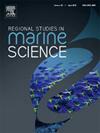Microplastics pollution and risk assessment in two urban rivers and an associated water treatment plant in Bangladesh
IF 2.1
4区 环境科学与生态学
Q3 ECOLOGY
引用次数: 0
Abstract
Microplastics (MPs) are considered emerging contaminants because they can potentially harm wildlife and humans. MPs in freshwater environments, especially in urban rivers, are less documented than those in marine habitats. This study examined the abundance, types, and distribution of MPs by collecting five (5) surface water samples from both the Buriganga and Shitalakshya rivers, in triplicate. Additionally, two (2) water samples were obtained from a nearby drinking water treatment plant (DWTP), also in triplicate. We further assessed the risks associated with microplastic contamination by calculating the pollution load index of the twelve sampling sites. The mean concentration of MPs in the Buriganga and Shitalakshya rivers was 12.4 p/L and 11.5 p/L, respectively; the MPs are mostly of transparent color (69%), in the shape of microfilms (71%), and < 1 mm in size (>90%). The DWTP showed similar microplastic concentrations in the inlet (8.7 particles/L) and outlet (7.3 particles/L), with no statistically significant difference (one-way ANOVA; p > 0.05). Polypropylene and polyethylene were identified as the most prevalent polymer kinds through analysis of infrared spectra, and the carbonyl index suggested that particles had undergone aging. A novel approach was taken to compute the pollution load index (PLI), which was subsequently employed for estimating the associated ecological risk. The Buriganga and Shitalakshya river waters were categorized as risk category Ⅳ and risk category Ⅲ, indicating the river waters are intermediately and seriously polluted, respectively. Policymakers and researchers are expected to take the findings of this study into cognizance and act accordingly to reduce the plastic loads of these two rivers.
孟加拉国两条城市河流和相关水处理厂的微塑料污染和风险评估
微塑料(MPs)被认为是新兴污染物,因为它们可能危害野生动物和人类。淡水环境中的MPs,尤其是城市河流中的MPs,比海洋栖息地中的MPs记录更少。本研究通过收集Buriganga河和Shitalakshya河的5个地表水样本,一式三份,检查了MPs的丰度、类型和分布。此外,从附近的饮用水处理厂(DWTP)获得了两(2)份水样,也是一式三份。通过计算12个采样点的污染负荷指数,我们进一步评估了微塑料污染的相关风险。布里干加河和希塔拉克什亚河中MPs的平均浓度分别为12.4 p/L和11.5 p/L;MPs大多为透明颜色(69%),微膜形状(71%),尺寸为<; 1 mm (>90%)。DWTP入口(8.7粒/L)和出口(7.3粒/L)微塑料浓度相近,差异无统计学意义(单因素方差分析;p 祝辞 0.05)。通过红外光谱分析,发现聚丙烯和聚乙烯是最常见的聚合物类型,羰基指数表明颗粒经历了老化。采用了一种新的方法来计算污染负荷指数(PLI),随后将其用于估算相关的生态风险。布里干加河和什塔拉克什亚河分别被划分为中度污染风险类别Ⅳ和严重污染风险类别Ⅲ。政策制定者和研究人员应该认识到这项研究的结果,并采取相应的行动来减少这两条河流的塑料负荷。
本文章由计算机程序翻译,如有差异,请以英文原文为准。
求助全文
约1分钟内获得全文
求助全文
来源期刊

Regional Studies in Marine Science
Agricultural and Biological Sciences-Ecology, Evolution, Behavior and Systematics
CiteScore
3.90
自引率
4.80%
发文量
336
审稿时长
69 days
期刊介绍:
REGIONAL STUDIES IN MARINE SCIENCE will publish scientifically sound papers on regional aspects of maritime and marine resources in estuaries, coastal zones, continental shelf, the seas and oceans.
 求助内容:
求助内容: 应助结果提醒方式:
应助结果提醒方式:


